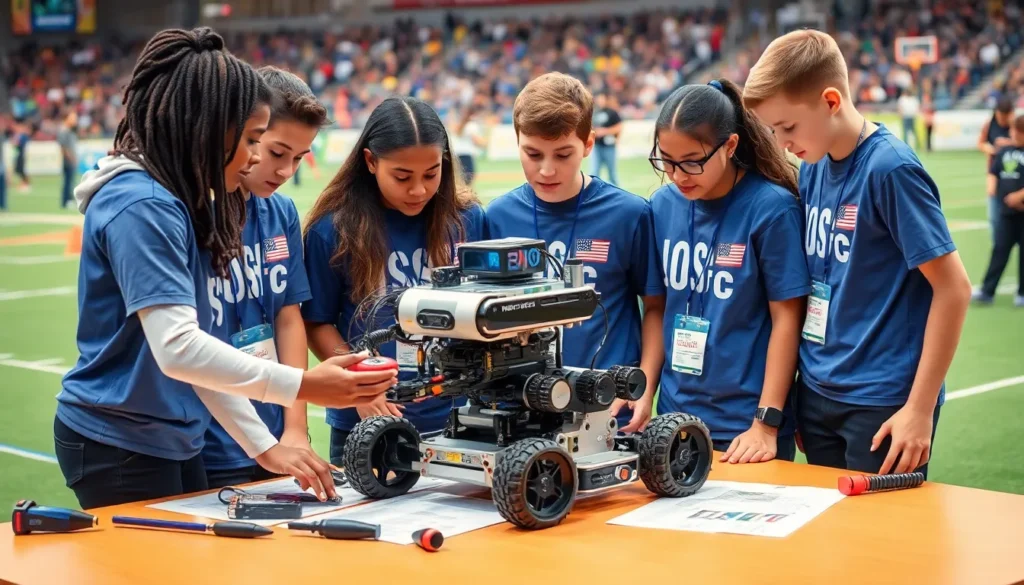When you think of sports, images of athletes sprinting down the field or diving into a pool might come to mind. But what if the next big star is a robot? As technology advances, the line between traditional sports and robotics blurs, leading to a fascinating debate: Is robotics a sport?
Table of Contents
ToggleUnderstanding Robotics Competitions
Robotics competitions showcase the convergence of engineering, technology, and strategy, all vying for supremacy. These events attract participants from various backgrounds, turning concepts into reality.
Types of Robotics Competitions
Robotics competitions fall into several categories, appealing to different interests and skill levels. Education-focused events introduce students to basic principles of robotics. Competitive platforms like FIRST Robotics allow teams to build sophisticated robots for specific challenges. Drone racing has gained popularity, pitting aerial bots against each other in thrilling races. Moreover, robotic combat leagues enable teams to design and fight robots in an arena, emphasizing engineering prowess and tactical maneuvering. These diverse formats highlight unique aspects of robotics, inviting creativity and innovation.
Key Players in the Industry
Numerous organizations drive the robotics competition landscape. FIRST Robotics engages high school students, fostering teamwork and problem-solving. VEX Robotics promotes STEM education through its competitive platforms. The Robotic Combat League provides thrilling combat events, attracting enthusiasts and engineers alike. In addition, universities such as MIT and Carnegie Mellon contribute research and talent, shaping future innovators in robotics. Sponsorships from tech giants like Google and Intel further enhance competition development, fueling the industry’s growth. Collectively, these players create a vibrant ecosystem that nurtures passion for robotics.
The Definition of Sport

Sports encompass various competitive activities requiring skill, physical exertion, and often teamwork. Understanding what constitutes a sport involves examining specific criteria that define athletic competition.
Criteria for Determining a Sport
Recognized standards typically include factors such as physical activity, skill development, and competitive rules. Events must have structured rules governing play and measurable objectives. Additionally, player participation in competitions occurs within a defined timeframe. Some activities, like chess, require mental agility rather than physical prowess but still fall under the sports umbrella due to their competitive nature.
Examples of Recognized Sports
Common examples encompass soccer, basketball, and swimming, which all emphasize physical skill and teamwork. Many also classify emerging activities like esports and drone racing as sports, reflecting changing perspectives on competitive engagement. Traditional sports may form the core, but innovative competitions continue to shape definitions in this evolving landscape. Robotics competitions also share similarities, appealing to creativity and technical skills while fostering healthy competition.
The Argument for Robotics as a Sport
Robotics competitions can be viewed as sports due to the high level of skill and strategy involved. Competitors design, program, and operate robots to complete complex tasks. Participants engage in critical thinking, refining their strategies based on opponents’ actions. Each event requires extensive preparation, including iterative testing and modification. Successful teams analyze performance metrics and adapt accordingly. These elements elevate robotics competitions to a level of strategic depth comparable to traditional sports.
Collaboration plays a central role in robotics competitions, highlighting teamwork in every stage of the process. Team members often possess diverse skill sets, from programming to mechanical design. Working together, teams share ideas and resources to enhance their robots’ performance. Effective communication remains crucial as members navigate challenges and develop solutions. Participants experience group dynamics similar to those found in team sports. They cultivate teamwork, forming bonds that strengthen their collaboration.
The Argument Against Robotics as a Sport
Opponents often highlight several key factors questioning robotics’ status as a sport. These arguments center primarily around the lack of physicality and the distinctions from traditional sports.
Lack of Physicality
Robotics doesn’t involve direct physical competition. Participants design and program robots while often remaining stationary during events. Many view this absence of physical exertion as a fundamental distinction between robotics competitions and traditional sports. While mental skill and technical expertise are essential, the physical activity that characterizes sports like soccer or basketball is notably absent. Critics argue that sports require physical endurance and fitness, emphasizing that competitive robotics lacks these components. Such a focus on intellect over physical prowess raises questions about categorizing robotics alongside established sports.
Comparison with Traditional Sports
Traditional sports feature clear rules, physical challenges, and immediate results from athletes’ actions. In robotics competitions, the outcomes depend more on engineering and programming than on athletic ability. Unlike basketball with its dribbling and shooting, robotics relies on programming logic and engineering design. Some argue that the excitement in robotics events stems from innovative technology rather than a display of athleticism. The nature of competition varies significantly, distinguishing robotics from the fast-paced environment of more conventional sports. As a result, critics maintain that while robotics competitions can be thrilling, they lack the essential characteristics defining traditional sports.
The debate over whether robotics qualifies as a sport reflects broader shifts in how society views competition and skill. As technology continues to evolve the lines between traditional sports and robotics competitions become increasingly blurred. The creativity teamwork and strategic thinking involved in robotics mirror the essence of sports.
While critics raise valid points about the physicality of robotics events the growing popularity and structured nature of these competitions suggest they deserve recognition in the sporting realm. As robotics gains traction it may just carve out its own niche within the world of competitive activities. Embracing this new frontier could lead to exciting developments in both technology and sportsmanship.





